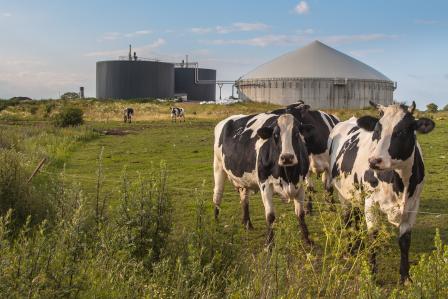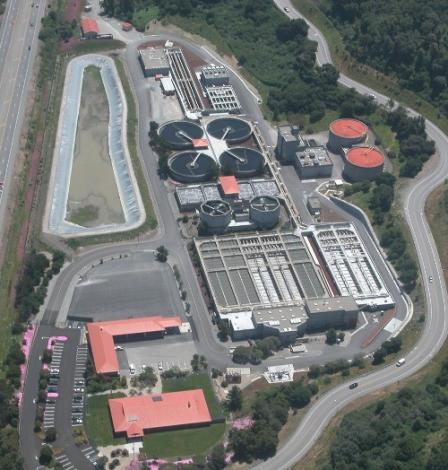Types of Anaerobic Digesters
All anaerobic digestion systems adhere to the same basic principles whether the feedstock is food waste, animal manure or wastewater sludge. Although the process is the same, designs will vary from digester to digester. Design variations are described below followed by descriptions of digester categories. The main categories of digesters are stand-alone digesters, on-farm digesters, and digesters at wastewater treatment plants.
Common Ways to Describe Digesters
Operating Temperature
Digesters are designed to run at different target temperature ranges. The temperature ranges are typically 86 - 100○ F for mesophillic and 122 - 140○ F for thermophilic. There are different populations of anaerobic microbes that thrive in these temperature zones.
Generally, thermophilic anaerobic digestion (AD) would be used when greater pathogen kill is necessary. This temperature range can produce "Class A Biosolids". Class A Biosolids is a designation for dewatered and heated sewage sludge that meets U.S. EPA guidelines for land application with no restrictions. Thus, Class A Biosolids can be legally used as fertilizer on farms, vegetable gardens, and can be sold to home gardeners as compost or fertilizer. Thermophillic digesters require less time to process feedstocks but may have higher costs and be more difficult to operate.
In general, mesophillic digesters are easier to operate and maintain, but will not result in sufficient pathogen kill to produce Class A Biosolids.
Feedstock Variation
Some digesters are designed to process one type of feedstock and other digesters are designed to process multiple feedstocks. Co-digestion is often a driver for the development of anaerobic digesters. Many feedstocks require or can benefit from pre-processing before digestion (e.g., blending, screening, thermal conditioning, etc.)
Wet (low-solids) and Dry (high-solids)
Wet and dry classifications of digesters refer to the moisture content of the feedstocks. Wet digesters are more common that dry. A wet digester or low solids AD system generally processes feedstock with less than 15 percent solids content. The feedstocks for a wet digester are typically in slurry form and can be pumped.
A dry digester or a high solids AD system generally processes feedstock with greater than 15 percent solids content. The feedstocks for a dry digester are often described as stackable.
Batch versus Continuous Flow
In a batch digester, feedstocks are loaded into the digester all at once. Following loading there is a set period of time for digestion to occur. Following this time period, the digester is manually emptied and reloaded.
In a continuous flow digester, feedstocks are constantly fed into the digester and digested material is continuously removed.
Stand-Alone Digesters
Most stand-alone digesters accept and process feedstocks from one or more sources for a tipping fee. Stand-alone digesters can be operated as organics recycling businesses, community-based operations or built by a municipality to manage residential food waste.
Other stand-alone digesters are built to process industry specific wastes. This is common in the food and beverage industry. These digesters are co-located at processing plants and are designed to process a certain kind of material. These units typically do not accept other feedstocks from offsite sources.
The primary feedstock processed in stand-alone digesters is food waste. However, digesters built to process food waste can also co-digest other organic materials, such as yard waste, manures and wastewater solids.
Demand for stand-alone digesters is increasing to address the increase of diversion of food waste from landfills.
On-Farm Digesters
On-farm digesters can bring great value to farmers  Photo of a dairy farm with anaerobic digestion system tanks in the background and cows in the foreground. and the surrounding community. Digesters can help farmers manage nutrients, reduce odors, and generate additional farm revenue. Dairy, swine and poultry are the primary animal types for farms with digesters. On-farm digesters can also accept outside food waste as a feedstock.
Photo of a dairy farm with anaerobic digestion system tanks in the background and cows in the foreground. and the surrounding community. Digesters can help farmers manage nutrients, reduce odors, and generate additional farm revenue. Dairy, swine and poultry are the primary animal types for farms with digesters. On-farm digesters can also accept outside food waste as a feedstock.
The most common digester system technologies on farms in the United States are: plug flow, complete mix, and covered lagoons.
Learn more about on-farm digesters and how value can be recovered from waste (manure)
The type of digester used on farms is typically determined by the manure management practices in place and type of animal manure that is fed into the digester. Biogas collected from the anaerobic digester systems is often used to generate electricity, to fuel boilers or furnaces, or to provide combined heat and power.
As of January 2019 there are 248 operating digesters on livestock farms in the United States. This data is tracked by EPA’s AgSTAR program.
Learn more about AgSTAR Data and Trends
Digesters at Water Resource Recovery Facilities
Plant operators, industry associations, research institutions,  Aerial photo of the two anaerobic digesters at the Central Marin Sanitation Agency treatment plant in San Rafael, CA.and state and federal agencies are now using the term “Water Resource Recovery Facility (WRRF)” to refer to Wastewater Treatment Facilities (also known as Publicly Owned Treatment Works or POTWs). The term “Water Resources Recovery Facility” acknowledges their ability to produce clean water, recover nutrients (such as phosphorus and nitrogen), and reduce our dependence on fossil fuel through the production and use of renewable energy.
Aerial photo of the two anaerobic digesters at the Central Marin Sanitation Agency treatment plant in San Rafael, CA.and state and federal agencies are now using the term “Water Resource Recovery Facility (WRRF)” to refer to Wastewater Treatment Facilities (also known as Publicly Owned Treatment Works or POTWs). The term “Water Resources Recovery Facility” acknowledges their ability to produce clean water, recover nutrients (such as phosphorus and nitrogen), and reduce our dependence on fossil fuel through the production and use of renewable energy.
The use of anaerobic digestion at WRRFs in the United States dates back to the early 1900’s. Over the last century, there have been both advancements and setbacks in the development of the technology. Anaerobic digestion is both a biological process and an engineered system that requires expertise in both disciplines for success.
The primary purpose of anaerobic digesters at WRRFs is to treat wastewater solids. As a result, these digesters are subject to EPA biosolids regulations (40 CFR Part 503). WRRF digesters vary in a number of ways including:
- size and shape;
- processing rate,
- number of stages to the process,
- operating temperature,
- extent of pre-digestion processing; and
- types of mixing strategies.
In the United States, over 1,200 WRRFs have anaerobic digesters that treat wastewater solids and produce biogas. While a number of these WRRFs flare-off the biogas produced in this process, more than half use the biogas they produce as an energy resource for producing electricity or usable heat. Of the facilities using their biogas for energy, about one third are generating electricity that is used for operations at the facility. Of the WRRFs generating electricity from biogas, almost 10 percent sell this electricity to the grid. About 2 percent of the WRRFs with digesters process the biogas into a form that is pure enough to inject into natural gas pipelines.
These uses of biogas generated at WRRFs are documented in a database maintained by the Water Environment Federation (WEF).
